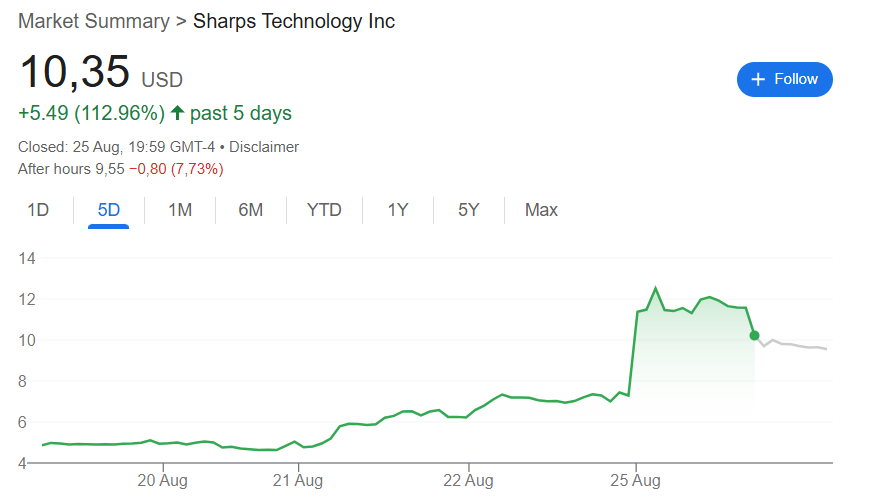Sharps Technology Raises $400M for Solana Treasury as Health Sector Embraces Crypto
TLDR
- Sharps Technology stock jumped 70-96% after announcing $400 million fundraising for Solana treasury strategy
- Major crypto investors ParaFi, Pantera, FalconX, CoinFund and Arrington Capital backed the deal
- Solana Foundation committed to sell $50 million in SOL tokens at 15% discount to 30-day average price
- Alice Zhang from Jambo joined as Chief Investment Officer to lead the crypto pivot
- Deal follows trend of health sector companies like Hoth Therapeutics and Atai Life Sciences adding crypto to balance sheets
Sharps Technology announced a major shift into cryptocurrency Monday, revealing a $400 million fundraising plan to build what could become the largest corporate Solana treasury. The medical device maker’s stock surged as much as 96% from $7.40 to an intraday high of $14.53.
 Source: Google Finance
Source: Google Finance
The fundraising attracted backing from top crypto investment firms including ParaFi, Pantera, FalconX, CoinFund and Arrington Capital. Shares were priced at $6.50 per unit with attached warrants exercisable at $9.75.
The deal is structured as a private investment in public equity transaction. This financing method allows accredited investors to buy shares of publicly traded companies at a discount to current market prices.
Closing is expected by August 28. The stock pared some gains throughout the day but remained up over 50% from Friday’s close of $7.30.
Leadership Changes Drive Strategy
Sharps appointed Alice Zhang, co-founder of Solana-backed project Jambo, as chief investment officer and board member. James Zhang also joined as a strategic adviser, bringing deep Solana ecosystem experience to the company.
The Solana Foundation agreed to sell $50 million in SOL tokens at a 15% discount to the 30-day time-weighted average price. This commitment provides immediate access to discounted tokens for the new treasury strategy.
Health Sector Crypto Adoption
Sharps joins a growing number of health sector companies pivoting to crypto treasuries. These firms hold digital assets on their balance sheets to give investors indirect exposure to cryptocurrency markets.
Hoth Therapeutics allocated $1 million in Bitcoin in November 2024 as an inflation hedge. The New York biopharma company develops therapies for skin, cancer and autoimmune diseases.
Atai Life Sciences followed in March with a $5 million Bitcoin purchase. The Nasdaq-listed company develops psychedelic-based mental health treatments and cited the cash-intensive nature of drug development.
180 Life Sciences took the most aggressive approach in July, rebranding as ETHZilla and planning a $425 million Ether treasury. The biotech’s stock had fallen 99% before the pivot.
Broader Market Activity
Other companies are pursuing similar Solana-focused strategies. Galaxy Digital, Multicoin Capital and Jump Crypto are reportedly raising $1 billion for a SOL treasury through acquiring a listed firm.
DeFi Development announced plans to raise $125 million through equity sales to increase SOL holdings. However, their stock dropped 19% on the news, showing mixed market reception.
The digital asset treasury model was pioneered by Michael Saylor’s Strategy in 2020. Strategy now holds over $70 billion worth of Bitcoin, making it the largest corporate holder.
Charles Schwab recently warned that companies investing large amounts in volatile assets unrelated to their core business raises red flags. The Wall Street firm highlighted risks in an educational video about the trend.
The post Sharps Technology Raises $400M for Solana Treasury as Health Sector Embraces Crypto appeared first on CoinCentral.
You May Also Like

US Spot ETH ETFs Witness Remarkable $244M Inflow Surge

First Ethereum Treasury Firm Sells ETH For Buybacks: Death Spiral Incoming?

